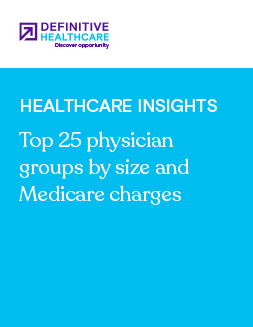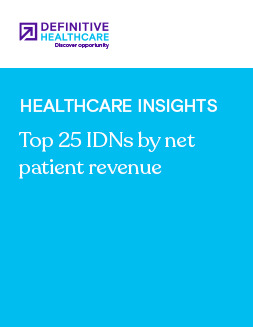Healthcare Insights
Top 10 musculoskeletal procedure codes
The musculoskeletal system is a complex system that provides structure and support to the body. It is essential for human movement and function.
As people age, the musculoskeletal system undergoes several changes: bones become less dense, muscles become weaker, and joints can become stiff. These changes can lead to common problems like osteoporosis and an increased risk of injury.
Understanding musculoskeletal conditions and procedures will be increasingly important as the U.S. population ages. Using data from the Definitive Healthcare Atlas All-Payor Claims product, we put together a list of the top procedure codes related to the musculoskeletal system for calendar year 2022.
| Rank | CPT code | CPT description | % of MSK procedures in U.S. | Average charge of MSK procedure in U.S. | Explore dataset |
|---|---|---|---|---|---|
| 1 | 20610 | Drain/injection major joint/bursa w/o ultrasound | 21.2% | $354 | Explore |
| 2 | 20550 | Injection tendon sheath/ligament | 4.2% | $253 | Explore |
| 3 | 20611 | Drain/injection joint/bursa with ultrasound | 4.1% | $504 | Explore |
| 4 | 27447 | Total knee arthroplasty | 3.0% | $15,731 | Explore |
| 5 | 20553 | Inject trigger points 3 or more muscles | 2.2% | $457 | Explore |
| 6 | 20605 | Drain/injection intermediate joint/bursa without ultrasound | 2.0% | $282 | Explore |
| 7 | 27130 | Total hip arthroplasty | 1.8% | $16,747 | Explore |
| 8 | 20600 | Drain/injection small joint/bursa without ultrasound | 1.8% | $291 | Explore |
| 9 | 29581 | Apply multi-layer compression system lower leg | 1.7% | $473 | Explore |
| 10 | 20552 | Injection trigger point 1/2 muscle | 1.7% | $345 | Explore |
Fig. 1. Data is from the Definitive Healthcare Atlas All-Payor Claims product for calendar year 2022. Claims data is sourced from multiple medical claims clearinghouses in the United States and is updated monthly. Data is accurate as of July 2023.
Which musculoskeletal CPT codes have the most procedures?
CPT code 20610 was the most common musculoskeletal procedure, with 21.2% of procedures in 2022. This code is used to report aspirating fluid from, or injecting medication into, a major joint or bursa, without ultrasound guidance. The procedure can be performed on any major joint, such as the shoulder, hip, knee, or subacromial bursa.
CPT code 20550 ranked second, with 4.2% of musculoskeletal procedures. This code is used to report injecting medication into a single tendon sheath, ligament, or aponeurosis, such as the plantar fascia.
CPT code 20611 ranked third, with 4.1% of musculoskeletal procedures. This code is used to report aspirating fluid from, or injecting medication into, a major joint or bursa using ultrasound guidance.
Four codes on the list, 20610, 20611, 20605, and 20600, relate to arthrocentesis procedures. These accounted for around one-third of total procedures across all musculoskeletal procedure codes in the U.S. in 2022.
Arthrocentesis is a medical procedure that involves the removal of fluid from a joint or bursa. It can be used to diagnose and treat a variety of joint conditions, including arthritis, gout, and infectious processes such as septic arthritis.
Which musculoskeletal CPT code has the highest average charge?
Code 27447, total hip arthroplasty, had the highest average charge at $16,747. Also known as a hip replacement, it’s a relatively common surgical procedure done to relieve pain and improve hip function. The procedure replaces a damaged or worn-out hip joint with an artificial joint made of metal and plastic designed to mimic the movement of the natural hip joint. Total hip replacement is often used to treat osteoarthritis, which is a condition that causes the cartilage in the hip joint to break down.
What are common types of musculoskeletal system procedures?
There are many different kinds of musculoskeletal system procedures, but some of the most common include:
- Arthroscopy: This is a minimally invasive procedure that uses a small camera to view the inside of a joint. Arthroscopy is often used to diagnose and treat conditions such as torn cartilage, arthritis, and loose bodies in the joint.
- Joint replacement: This is a surgical procedure to replace a damaged joint with an artificial joint. Joint replacement treats conditions such as osteoarthritis, rheumatoid arthritis, and traumatic injuries.
- Soft tissue repair: This surgical procedure repairs a torn tendon or ligament. Tendons are the tissues that connect muscles to bones. Ligaments are the tissues that connect bones to each other.
- Bone fusion: This is a surgical procedure that fuses two or more bones together. Bone fusion is often used to treat conditions such as arthritis, spinal deformity, and traumatic injuries.
- Open reduction: This surgical procedure repairs a broken bone. It involves realigning the bone fragments and then stabilizing them with plates, screws, or pins. This is done when the bone fragments are too displaced or unstable to be aligned closed, meaning without making an incision.
What is the CPT code for musculoskeletal procedure?
There are several CPT codes for musculoskeletal procedures. These codes range from CPT code 20100-29999. This range includes a wide variety of procedures that vary depending on the specific procedure performed. For example, the CPT code for a total knee replacement is 27447, while the CPT code for a total hip arthroplasty is 27130.
What is the musculoskeletal system?
Themusculoskeletal system is the collection of bones, ligaments, cartilage, connective tissue, and tendons in the body. These parts of the skeleton help support soft tissues, muscles, and body weight. They also allow people to move and maintain posture.
Musculoskeletal pain can arise for a variety of reasons, including:
- Injury
- Aging
- Disease
- Birth defects
Learn more
Healthcare Insights are developed with healthcare commercial intelligence from the Definitive Healthcare platform. Want even more insights? Start a free trial now and get access to the latest healthcare commercial intelligence on hospitals, physicians and other healthcare providers.


